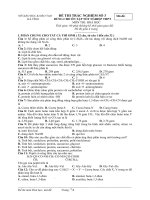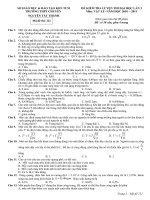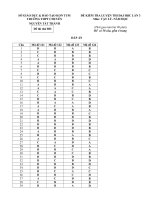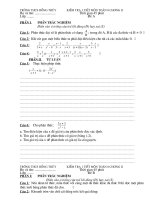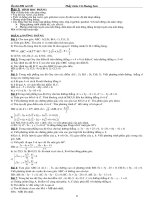Luyện thi GRE math review 3 geometry
Bạn đang xem bản rút gọn của tài liệu. Xem và tải ngay bản đầy đủ của tài liệu tại đây (1.87 MB, 54 trang )
GRADUATE RECORD EXAMINATIONS®
Math Review
Chapter 3: Geometry
Copyright © 2010 by Educational Testing Service. All
rights reserved. ETS, the ETS logo, GRADUATE RECORD
EXAMINATIONS, and GRE are registered trademarks of
Educational Testing Service (ETS) in the United States and other
countries.
GRE Math Review 3 Geometry
1
The GRE
®
Math Review consists of 4 chapters: Arithmetic, Algebra, Geometry, and Data
Analysis. This is the accessible electronic format (Word) edition of the Geometry Chapter
of the Math Review. Downloadable versions of large print (PDF) and accessible electronic
format (Word) of each of the 4 chapters of the Math Review, as well as a Large Print
Figure supplement for each chapter are available from the GRE
®
website. Other
downloadable practice and test familiarization materials in large print and accessible
electronic formats are also available. Tactile figure supplements for the 4 chapters of the
Math Review, along with additional accessible practice and test familiarization materials in
other formats, are available from E T S Disability Services Monday to Friday 8:30 a m to 5
p m New York time, at 1-6 0 9-7 7 1-7 7 8 0, or 1-8 6 6-3 8 7-8 6 0 2 (toll free for test
takers in the United States, U S Territories and Canada), or via email at
The mathematical content covered in this edition of the Math Review is the same as the
content covered in the standard edition of the Math Review. However, there are
differences in the presentation of some of the material. These differences are the result of
adaptations made for presentation of the material in accessible formats. There are also
slight differences between the various accessible formats, also as a result of specific
adaptations made for each format.
Information for screen reader users:
This document has been created to be accessible to individuals who use screen readers.
You may wish to consult the manual or help system for your screen reader to learn how
best to take advantage of the features implemented in this document. Please consult the
separate document, GRE Screen Reader Instructions.doc, for important details.
Figures
GRE Math Review 3 Geometry
2
The Math Review includes figures. In accessible electronic format (Word) editions, figures
appear on screen. Following each figure on screen is text describing that figure. Readers
using visual presentations of the figures may choose to skip parts of the text describing the
figure that begin with “Begin skippable part of description of …” and end with “End
skippable figure description.”
Mathematical Equations and Expressions
The Math Review includes mathematical equations and expressions. In accessible
electronic format (Word) editions some of the mathematical equations and expressions are
presented as graphics. In cases where a mathematical equation or expression is presented
as a graphic, a verbal presentation is also given and the verbal presentation comes directly
after the graphic presentation. The verbal presentation is in green font to assist readers in
telling the two presentation modes apart. Readers using audio alone can safely ignore the
graphical presentations, and readers using visual presentations may ignore the verbal
presentations.
GRE Math Review 3 Geometry
3
Table of Contents
Table of Contents..............................................................................................................4
Overview of the Math Review..............................................................................................5
Overview of this Chapter......................................................................................................5
3.1 Lines and Angles.............................................................................................................6
3.2 Polygons........................................................................................................................11
3.3 Triangles........................................................................................................................13
3.4 Quadrilaterals................................................................................................................22
3.5 Circles............................................................................................................................27
3.6 Three Dimensional Figures...........................................................................................35
Answers to Geometry Exercises.........................................................................................52
GRE Math Review 3 Geometry
4
Overview of the Math Review
The Math Review consists of 4 chapters: Arithmetic, Algebra, Geometry, and Data
Analysis.
Each of the 4 chapters in the Math Review will familiarize you with the mathematical
skills and concepts that are important to understand in order to solve problems and reason
quantitatively on the Quantitative Reasoning measure of the GRE
®
revised General Test.
The material in the Math Review includes many definitions, properties, and examples, as
well as a set of exercises with answers at the end of each chapter. Note, however that this
review is not intended to be all inclusive. There may be some concepts on the test that are
not explicitly presented in this review. If any topics in this review seem especially
unfamiliar or are covered too briefly, we encourage you to consult appropriate
mathematics texts for a more detailed treatment.
Overview of this Chapter
The review of geometry begins with lines and angles and progresses to other plane figures,
such as polygons, triangles, quadrilaterals, and circles. The chapter ends with some basic
three dimensional figures. Coordinate geometry is covered in the Algebra chapter.
GRE Math Review 3 Geometry
5
3.1 Lines and Angles
Plane geometry is devoted primarily to the properties and relations of plane figures, such
as angles, triangles, other polygons, and circles. The terms “point”, “line”, and “plane” are
familiar intuitive concepts. A point has no size and is the simplest geometric figure. All
geometric figures consist of points. A line is understood to be a straight line that extends in
both directions without end. A plane can be thought of as a floor or a tabletop, except that
a plane extends in all directions without end and has no thickness.
Given any two points on a line, a line segment is the part of the line that contains the two
points and all the points between them. The two points are called endpoints. Line
segments that have equal lengths are called congruent line segments. The point that
divides a line segment into two congruent line segments is called the midpoint of the line
segment.
In Geometry Figure 1 below, A, B, C, and D are points on line
l.
Geometry Figure 1
Line segment AB consists of points A and B and all the points on the line between A and B.
According to Geometry Figure 1 above, the lengths of line segments AB, BC, and CD are
8, 6, and 6, respectively. Hence, line segments BC and CD are congruent. Since C is
halfway between B and D, point C is the midpoint of line segment BD.
GRE Math Review 3 Geometry
6
Sometimes the notation AB denotes line segment AB, and sometimes it denotes the length
of line segment AB. The meaning of the notation can be determined from the context.
When two lines intersect at a point, they form four angles. Each angle has a vertex at the
point of intersection of the two lines. For example, in Geometry Figure 2 below, lines
l sub 1 and l sub 2 intersect at point P, forming the four angles APC, CPB,
BPD, and DPA.
Geometry Figure 2
The first and the third of the angles, that is, angles APC and BPD, are called opposite
angles, also known as vertical angles. The second and fourth of the angles, that is angles
CPB and DPA are also opposite angles. Opposite angles have equal measures, and angles
that have equal measures are called congruent angles. Hence, opposite angles are
congruent. The sum of the measures of the four angles is 360º.
Sometimes the angle symbol
APC can be written as
GRE Math Review 3 Geometry
is used instead of the word “angle”. For example, angle
the angle symbol followed by APC.
7
Two lines that intersect to form four congruent angles are called perpendicular lines.
Each of the four angles has a measure of 90º. An angle with a measure of 90º is called a
right angle. Geometry Figure 3 below shows two lines,
that are perpendicular, denoted by
symbol, followed by l sub 2.
l sub 1 and l sub 2,
l sub 1, followed by the perpendicular
Geometry Figure 3
A common way to indicate that an angle is a right angle is to draw a small square at the
vertex of the angle, as shown in Geometry Figure 4 below, where P O N is a right angle.
GRE Math Review 3 Geometry
8
Geometry Figure 4
An angle with measure less than 90º is called an acute angle, and an angle with measure
between 90º and 180º is called an obtuse angle.
Two lines in the same plane that do not intersect are called parallel lines. Geometry Figure
5 below shows two lines,
l sub 1 and l sub 2, that are parallel, denoted by
l sub 1, followed by the parallel symbol, followed by l sub 2. The two lines are
intersected by a third line,
l sub 3, forming eight angles.
GRE Math Review 3 Geometry
9
Geometry Figure 5
Begin skippable part of description of Geometry Figure 5.
There are eight labeled angles in Geometry Figure 5, four at the intersection of
l sub 1 and l sub 3, and four at the intersection of
l sub 2 and l
sub 3. The four angles at each intersection, from the upper left angle, going clockwise, are
labeled xº, yº, xº, and yº.
End skippable part of figure description.
Note that four of the eight angles in Geometry Figure 5 have the measure xº, and the
remaining four angles have the measure yº, where x + y = 180.
GRE Math Review 3 Geometry
10
3.2 Polygons
A polygon is a closed figure formed by three or more line segments, called sides. Each
side is joined to two other sides at its endpoints, and the endpoints are called vertices. In
this discussion, the term “polygon” means “convex polygon”, that is, a polygon in which
the measure of each interior angle is less than 180°. Geometry Figure 6 below contains
examples of a triangle, a quadrilateral, and a pentagon, all of which are convex.
Geometry Figure 6
GRE Math Review 3 Geometry
11
The simplest polygon is a triangle. Note that a quadrilateral can be divided into 2
triangles by drawing a diagonal; and a pentagon can be divided into 3 triangles by
selecting one of the vertices and drawing 2 line segments connecting that vertex to the two
nonadjacent vertices, as shown in Geometry Figure 7 below.
Geometry Figure 7
If a polygon has n sides, it can be divided into
n minus 2 triangles. Since the sum of
the measures of the interior angles of a triangle is 180º, it follows that the sum of the
measures of the interior angles of an n sided polygon is
open parenthesis, n
minus 2, close parenthesis, times 180°. For example, since a quadrilateral has 4 sides, the
sum of the measures of the interior angles for a quadrilateral is
open parenthesis, 4 minus 2, close parenthesis, times 180° = 360°; and since a hexagon
has 6 sides, the sum of the measures of the interior angles for a hexagon is
open parenthesis, 6 minus 2, close parenthesis, times 180° = 720°.
GRE Math Review 3 Geometry
12
A polygon in which all sides are congruent and all interior angles are congruent is called a
regular polygon. For example, since an octagon has 8 sides, the sum of the measures of
the interior angles of an octagon is
open parenthesis, 8 minus 2,
close parenthesis, times 180° = 1,080°. Therefore, in a regular octagon the measure of
each angle is
1,080° over 8 = 135°.
The perimeter of a polygon is the sum of the lengths of its sides. The area of a polygon
refers to the area of the region enclosed by the polygon.
In the next two sections, we will look at some basic properties of triangles and
quadrilaterals.
3.3 Triangles
Every triangle has three sides and three interior angles. The measures of the interior angles
add up to 180°. The length of each side must be less than the sum of the lengths of the
other two sides. For example, the sides of a triangle could not have the lengths 4, 7, and 12
because 12 is greater than 4 + 7.
The following are 3 types of special triangles.
Type 1: A triangle with three congruent sides is called an equilateral triangle. The
measures of the three interior angles of such a triangle are also equal, and each measure
is 60º.
GRE Math Review 3 Geometry
13
Type 2: A triangle with at least two congruent sides is called an isosceles triangle. If a
triangle has two congruent sides, then the angles opposite the two sides are congruent.
The converse is also true. For example, in triangle ABC in Geometry Figure 8 below,
the measure of angle A is 50º, the measure of angle C is 50º, and the measure of angle
B is xº. Since both angle A and angle C have measure 50º, it follows that the length of
AB is equal to the length of BC. Also, since the sum of the 3 angles of a triangle is 180º,
it follows that 50 + 50 + x = 180, and the measure of angle B is 80º.
Geometry Figure 8
Type 3: A triangle with an interior right angle is called a right triangle. The side
opposite the right angle is called the hypotenuse; the other two sides are called legs.
GRE Math Review 3 Geometry
14
Geometry Figure 9
In right triangle D E F in Geometry Figure 9 above, side E F is the side opposite right
angle D, therefore E F is the hypotenuse and D E and D F are legs. The Pythagorean
theorem states that in a right triangle, the square of the length of the hypotenuse is equal to
the sum of the squares of the lengths of the legs. Thus, for triangle D E F in Geometry
Figure 9 above,
the length of E F squared = the length of D E squared, +, the
length of D F squared .
This relationship can be used to find the length of one side of a right triangle if the lengths
of the other two sides are known. For example, consider a right triangle with hypotenuse of
length 8, a leg of length 5, and another leg of unknown length x, as shown in Geometry
Figure 10 below.
GRE Math Review 3 Geometry
15
Geometry Figure 10
By the Pythagorean theorem
Therefore
8 squared = 5 squared, +, x squared.
64 = 25, +, x squared and 39 = x squared.
Since
x squared = 39 and x must be positive, it follows that
positive square root of 39, or approximately 6.2.
x = the
The Pythagorean theorem can be used to determine the ratios of the sides of two special
right triangles. One special right triangle is an isosceles right triangle, as shown in
Geometry Figure 11 below.
.
Geometry Figure 11
GRE Math Review 3 Geometry
16
In Geometry Figure 11, the hypotenuse of the right triangle is of length y, both legs are of
length x, and the angles opposite the legs are both 45 degree angles.
Applying the Pythagorean theorem to the isosceles right triangle in Geometry Figure 11
shows that the lengths of its sides are in the ratio 1 to 1 to
2, as follows.
By the Pythagorean theorem,
Therefore
the positive square root of
y squared = x squared + x squared.
y squared = 2, x squared and y = the positive square
root of 2, times x. So the lengths of the sides are in the ratio
positive square root of 2, times x, which is the same as the ratio 1 to 1 to
positive square root of 2.
x to x, to the
the
The other special right triangle is a 30º- 60º- 90º right triangle, which is half of an
equilateral triangle, as shown in Geometry Figure 12 below.
Geometry Figure 12
Begin skippable part of description of Geometry Figure 12.
GRE Math Review 3 Geometry
17
One of the sides of the equilateral triangle is horizontal and the other two sides meet at a
vertex of the triangle that lies above the horizontal side. A perpendicular line from the
vertex to the horizontal side of the triangle divides the equilateral triangle into two
congruent right triangles. Each right triangle has a horizontal leg of length x, a vertical leg
of length y and a hypotenuse of length 2x. The angle opposite the vertical leg has measure
60 degrees, and the angle opposite the horizontal leg has measure 30 degrees.
End skippable part of figure description.
Note that the length of the horizontal side, x, is one half the length of the hypotenuse, 2x.
Applying the Pythagorean theorem to the 30º- 60º- 90º right triangle shows that the lengths
of its sides are in the ratio
1 to the positive square root of 3 to 2 as follows.
By the Pythagorean theorem
x squared + y squared = open
parenthesis, 2x, close parenthesis, squared, which simplifies to
squared + y squared = 4, x squared.
x
Subtracting
x squared from both sides gives
y
squared = 4, x squared, minus x squared, or y squared = 3, x squared. Therefore,
y = the positive square root of 3, times x.
Hence, the ratio of the lengths of the three sides of a 30º- 60º- 90º right triangle is
x to the positive square root of 3, times x, to 2x, which is the same as
the ratio
1 to the positive square root of 3, to 2.
GRE Math Review 3 Geometry
18
The area A of a triangle equals one half the product of the length of a base and the height
corresponding to the base, or
A = bh, over 2. Geometry Figure 13 below shows a
triangle: the horizontal base of the triangle is denoted by b and the corresponding vertical
height is denoted by h.
Geometry Figure 13
Any side of a triangle can be used as a base; the height that corresponds to the base is the
perpendicular line segment from the opposite vertex to the base (or an extension of the
base). The examples in Geometry Figure 14 below show three different configurations of a
base and the corresponding height.
GRE Math Review 3 Geometry
19
Geometry Figure 14
Begin skippable part of description of Geometry Figure 14.
In all three triangles the base is a horizontal line segment of length 15, and the height is a
vertical line segment of length 6. In the first triangle, the angle at the left of the horizontal
base is an acute angle and the height goes to the base. In the second triangle, the angle at
the left of the horizontal base is a right angle and the height is the vertical side of the right
triangle. In the third triangle, the angle at the left of the horizontal base is an obtuse angle
and the height goes to an extension of the base.
End skippable part of figure description.
In all three triangles in Geometry Figure 14 above, the area is
or 45.
GRE Math Review 3 Geometry
15 times 6, over 2,
20
Two triangles that have the same shape and size are called congruent triangles. More
precisely, two triangles are congruent if their vertices can be matched up so that the
corresponding angles and the corresponding sides are congruent.
The following three propositions can be used to determine whether two triangles are
congruent by comparing only some of their sides and angles.
Proposition 1: If the three sides of one triangle are congruent to the three sides of
another triangle, then the triangles are congruent.
Proposition 2: If two sides and the included angle of one triangle are congruent to two
sides and the included angle of another triangle, then the triangles are congruent.
Proposition 3: If two angles and the included side of one triangle are congruent to two
angles and the included side of another triangle, then the triangles are congruent.
Two triangles that have the same shape but not necessarily the same size are called similar
triangles. More precisely, two triangles are similar if their vertices can be matched up so
that the corresponding angles are congruent or, equivalently, the lengths of corresponding
sides have the same ratio, called the scale factor of similarity. For example, all 30º-60º90º right triangles, are similar triangles, though they may differ in size.
When we say that triangles ABC and D E F are similar, it is assumed that angles A and D
are congruent, angles B and E are congruent, and angles C and F are congruent, as shown
in Geometry Figure 15 below. Also sides AB, BC, and AC in triangle ABC correspond to
sides D E, E F, and DF in triangle D E F, respectively. In other words, the order of the
letters indicates the correspondences.
GRE Math Review 3 Geometry
21
Geometry Figure 15
Since triangles ABC and D E F are similar, we have
AB over D E =
BC over E F = AC over DF. By cross multiplication, we can obtain other proportions, such
as
AB over BC = D E over E F.
3.4 Quadrilaterals
Every quadrilateral has four sides and four interior angles. The measures of the interior
angles add up to 360°. The following are four special types of quadrilaterals.
Type 1: A quadrilateral with four right angles is called a rectangle. Opposite sides of a
rectangle are parallel and congruent, and the two diagonals are also congruent.
GRE Math Review 3 Geometry
22
Geometry Figure 16
Geometry Figure 16 above shows rectangle ABCD.
In rectangle ABCD, opposite sides AD and BC are parallel and congruent,
opposite sides AB and DC are parallel and congruent, and
diagonal AC is congruent to diagonal BD.
Type 2: A rectangle with four congruent sides is called a square.
Type 3: A quadrilateral in which both pairs of opposite sides are parallel is called a
parallelogram. In a parallelogram, opposite sides are congruent and opposite angles
are congruent.
GRE Math Review 3 Geometry
23
Geometry Figure 17
Geometry Figure 17 above shows parallelogram PQRS.
In parallelogram PQRS,
opposite sides PQ and SR are parallel and congruent,
opposite sides QR and PS are parallel and congruent,
opposite angles Q and S are congruent, and
opposite angles P and R are congruent.
In the figure angles Q and S are both labeled xº, and angles P and R are both labeled
yº.
Type 4: A quadrilateral in which two opposite sides are parallel is called a trapezoid.
Geometry Figure 18
GRE Math Review 3 Geometry
24
Geometry Figure 18 above shows trapezoid KLMN. In trapezoid KLMN, horizontal
side KN is parallel to horizontal side LM.
For all parallelograms, including rectangles and squares, the area A equals the product of
the length of a base b and the corresponding height h; that is,
A = bh.
Any side can be used as a base. The height corresponding to the base is the perpendicular
line segment from any point of a base to the opposite side (or an extension of that side). In
Geometry Figure 19 below are examples of finding the areas of a rectangle and a
parallelogram.
Geometry Figure 19
GRE Math Review 3 Geometry
25
